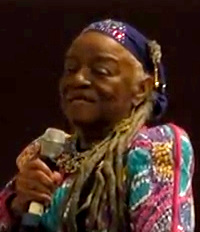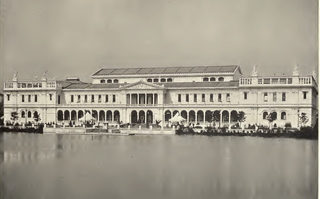Related Research Articles

Lesbian feminism is a cultural movement and critical perspective that encourages women to focus their efforts, attentions, relationships, and activities towards their fellow women rather than men, and often advocates lesbianism as the logical result of feminism. Lesbian feminism was most influential in the 1970s and early 1980s, primarily in North America and Western Europe, but began in the late 1960s and arose out of dissatisfaction with the New Left, the Campaign for Homosexual Equality, sexism within the gay liberation movement, and homophobia within popular women's movements at the time. Many of the supporters of Lesbianism were actually women involved in gay liberation who were tired of the sexism and centering of gay men within the community and lesbian women in the mainstream women's movement who were tired of the homophobia involved in it.

Faith Ringgold is an American painter, painting on different materials including fabric, a published author, mixed media sculptor, performance artist, and intersectional activist, perhaps best known for her narrative quilts.
The Woman's Building was a non-profit arts and education center located in Los Angeles, California. The Woman's Building focused on feminist art and served as a venue for the women's movement and was spearheaded by artist Judy Chicago, graphic designer Sheila Levrant de Bretteville and art historian Arlene Raven. The center was open from 1973 until 1991. During its existence, the Los Angeles Times called the Woman's Building a "feminist mecca."
Faith Wilding is a Paraguayan American multidisciplinary artist - which includes but is not limited to: watercolor, performance art, writing, crocheting, knitting, weaving, and digital art. She is also an author, educator, and activist widely known for her contribution to the progressive development of feminist art. She also fights for ecofeminism, genetics, cyberfeminism, and reproductive rights. Wilding is Professor Emerita of performance art at the School of the Art Institute of Chicago.
The Smith Museum of Stained Glass Windows was an exhibition that opened in February 2000 at Chicago’s Navy Pier entertainment complex. It permanently closed in October 2014. It was the first American museum dedicated solely to the art of stained glass windows.

The feminist art movement in the United States began in the early 1970s and sought to promote the study, creation, understanding and promotion of women's art. First-generation feminist artists include Judy Chicago, Miriam Schapiro, Suzanne Lacy, Judith Bernstein, Sheila de Bretteville, Mary Beth Edelson, Carolee Schneeman, Rachel Rosenthal, and many other women. They were part of the Feminist art movement in the United States in the early 1970s to develop feminist writing and art. The movement spread quickly through museum protests in both New York and Los Angeles, via an early network called W.E.B. that disseminated news of feminist art activities from 1971 to 1973 in a nationally circulated newsletter, and at conferences such as the West Coast Women's Artists Conference held at California Institute of the Arts and the Conference of Women in the Visual Arts, at the Corcoran School of Art in Washington, D.C..
SOHO20 Artists, Inc., known as SOHO20 Gallery, was founded in 1973 by a group of women artists intent on achieving professional excellence in an industry where there was a gross lack of opportunities for women to succeed. SOHO20 was one of the first galleries in Manhattan to showcase the work of an all-woman membership and most of the members joined the organization as emerging artists. These artists were provided with exhibition opportunities that they could not find elsewhere.
Harmony Hammond is an American artist, activist, curator, and writer. She was a prominent figure in the founding of the feminist art movement in 1970s New York.
The National Association of Women Artists, Inc. (NAWA) is a United States organization, founded in 1889 to gain recognition for professional women fine artists in an era when that field was strongly male-oriented. It sponsors exhibitions, awards and prizes, and organizes lectures and special events.
The Women's Caucus for Art (WCA), founded in 1972, is a non-profit organization based in New York City, which supports women artists, art historians, students, educators, and museum professionals. The WCA holds exhibitions and conferences to promote women artists and their works and recognizes the talents of artists through their annual Lifetime Achievement Award. Since 1975 it has been a United Nations-affiliated non-governmental organization (NGO), which has broadened its influence beyond the United States. Within the WCA are several special interest causes including the Women of Color caucus, Eco-Art Caucus, Jewish Women Artist Network, International Caucus and the Young Women's Caucus. The founding of the WCA is seen as a "great stride" in the feminist art movement.
"Where We At" Black Women Artists, Inc. (WWA) was a collective of Black women artists affiliated with the Black Arts Movement of the 1960s and 1970s. It included artists such as Dindga McCannon, Kay Brown, Faith Ringgold, Carol Blank, Jerri Crooks, Charlotte Kâ (Richardson), and Gylbert Coker. Where We At was formed in the spring of 1971, in the wake of an exhibition of the same name organized by 14 Black women artists at the Acts of Art Gallery in Greenwich Village. Themes such as the unity of the Black family, Black female independence and embodiment, Black male-female relationships, contemporary social conditions, and African traditions were central to the work of the WWA artists. The group was intended to serve as a source of empowerment for African-American women, providing a means for them to control their self-representation and to explore issues of Black women's sensibility and aesthetics. Like AfriCobra, a Chicago-based Black Arts group, the WWA was active in fostering art within the African-American community and using it as a tool of awareness and liberation. The group organized workshops in schools, jails and prisons, hospitals, and cultural centers, as well as art classes for youth in their communities.
The feminist art movement refers to the efforts and accomplishments of feminists internationally to produce art that reflects women's lives and experiences, as well as to change the foundation for the production and perception of contemporary art. It also seeks to bring more visibility to women within art history and art practice. The movement challenges the traditional hierarchy of arts over crafts, which views hard sculpture and painting as superior to the narrowly perceived 'women's work' of arts and crafts such as weaving, sewing, quilting and ceramics. Women artists have overturned the traditional view by, for example, using unconventional materials in soft sculptures, new techniques such as stuffing, hanging and draping, and for new purposes such as telling stories of their own life experiences. The objectives of the feminist art movement are thus to deconstruct the traditional hierarchies, represent women more fairly and to give more meaning to art. It helps construct a role for those who wish to challenge the mainstream narrative of the art world. Corresponding with general developments within feminism, and often including such self-organizing tactics as the consciousness-raising group, the movement began in the 1960s and flourished throughout the 1970s as an outgrowth of the so-called second wave of feminism. It has been called "the most influential international movement of any during the postwar period."

Dindga McCannon is an African-American artist, fiber artist, muralist, teacher author and illustrator. She co-founded the collective Where We At, Black Women Artists in 1971.
Chicago Project Room (CPR) was a contemporary art gallery founded in 1996 by Michael Hall in Chicago.

The Woman's Building was designed and built for the World's Columbian Exposition held in Chicago in 1893 under the auspices of the Board of Lady Managers. Of the twelve main buildings for the Exhibition, on June 30, 1892 The Woman's Building was the first to be completed. It had exhibition space as well as an assembly room, a library, and a Hall of Honor. The History of the World's Fair states, "It will be a long time before such an aggregation of woman's work, as may now be seen in the Woman's Building, can be gathered from all parts of the world again."
Deborah Bright is a 20th-century American photographer and artist, writer, and educator. She is particularly noted for her imagery and scholarship on queer desire and politics, as well as on the ideologies of American landscape photography. Her work is in the collections of the Smithsonian American Art Museum, the Fogg Art Museum, and the Whitney Museum of American Art. Bright's photographic projects have been exhibited internationally.
Artemisia Gallery was an alternative exhibition space in Chicago, Illinois, United States, that operated from 1973 until its closure in 2003.
ARC Gallery is an alternative exhibition space in Chicago, Illinois. Opening in 1973, it was one of the first women artists’ cooperatives in the Midwest along with Artemisia Gallery. ARC stands for Artists, Residents, Chicago and is one of the longest running women’s cooperative galleries in the country. The original members, recent art school graduates, banded together because they found few female mentors and exhibition opportunities. Through ARC, the members were able to promote their own artwork, feature solo and group exhibitions by many artists from across the county, and create discourse around feminism, art, theory, and practice. In 1979, ARC founded RAWspace, a raw part of the gallery dedicated to exhibiting installation work by visiting artists, selected by ARC members. RAWspace was one of the pioneering spaces in Chicago for the exhibition of installation work.
Volume Gallery is a commercial art gallery focused on design and contemporary art. It is located in West Town, Chicago. Volume Gallery represents artists and designers working in diverse disciplines such as ceramics, fiber, glass, and object design. The gallery presents seven curated thematic and solo exhibitions a year with an emphasis on emerging and mid-career artists.
Judith Kapstein Brodsky is an American artist, curator, and author known for her contributions to feminist discourse in the arts. She received her B.A. from Harvard University where she majored in Art History, and an M.F.A. from Tyler School of Art at Temple University. She is Professor Emerita in the Department of Visual Arts at Rutgers, State University of New Jersey. A printmaker herself, Brodsky is founding Director of the Rutgers Center for Innovative Print and Paper in 1996, later renamed the Brodsky Center in her honor in September 2006, and which later joined the Philadelphia Academy of Fine Arts (PAFA) in 2018. She was also co-founder, with Ferris Olin, of the Center for Women in the Arts and Humanities at Rutgers University in 2006. She was the first artist appointed as president of the Women's Caucus for Art, an active Affiliated Society of the College Art Association.
References
- ↑ "A New Vision for Chicago's Oldest Feminist Gallery". Hyperallergic. Retrieved 14 October 2013.
- ↑ "Woman Made Gallery marks 25 years, new location - Gay Lesbian Bi Trans News Archive". Windy City Times. Retrieved 2019-01-25.
- ↑ "About Us". Woman Made Gallery. Retrieved 14 October 2013.
- ↑ Owens Anderson, Joyce (Winter 2019). "We Flew Over the Bridge: The Memoirs of Faith Ringgold". The Journal of African American History. 91: 364–365 – via jstor.
- ↑ Figliulo, Susan. "Prairie Avenue Historic District: What's Left". Chicago Reader. Retrieved 2019-01-25.
- ↑ Jepsen, Cara. "Woman Made's Fixer-Upper". Chicago Reader. Retrieved 2019-01-25.
- ↑ "Woman Made Gallery marks 25 years, new location - Gay Lesbian Bi Trans News Archive". Windy City Times. Retrieved 2019-01-25.
- ↑ "ARC & Woman Made Gallery on the Issue of Feminism : Chicago Art Magazine". chicagoartmagazine.com. Retrieved 2019-01-25.
- ↑ "History". Woman Made Gallery. Retrieved 14 October 2013.